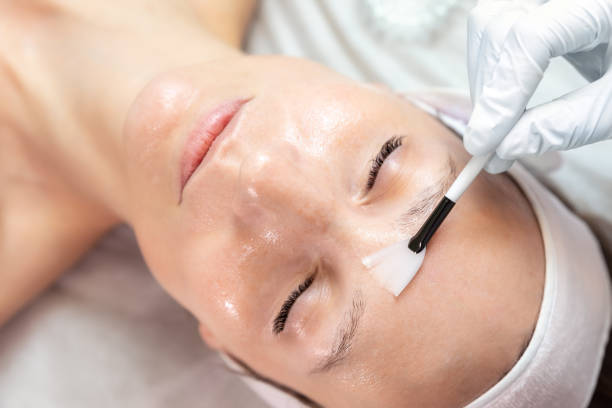Chemical peels in Abu Dhabi offer a versatile solution for addressing various skin concerns, from acne scars to signs of aging. However, selecting the right chemical peel for your specific skin concerns is essential to achieve optimal results and minimize the risk of adverse reactions. Understanding the different types of chemical peels and their suitability for various skin issues can help individuals make informed decisions about their skincare treatments.
Introduction to Chemical Peels
Chemical peels are cosmetic treatments that involve the application of a chemical solution to the skin, causing it to exfoliate and eventually peel off. This process promotes cell turnover, revealing smoother, more radiant skin underneath. Chemical peels are available in different strengths and formulations, ranging from superficial to deep, each targeting specific skin concerns and conditions.
Types of Chemical Peels
There are several types of chemical peels available, each with its own set of ingredients, strengths, and benefits:
Superficial Peels
Superficial peels are the mildest form of chemical peels, primarily targeting the outer layer of the skin (epidermis). They are typically composed of alpha hydroxy acids (AHAs) or beta hydroxy acids (BHAs) and are used to improve skin texture, tone, and mild discoloration.
Medium Peels
Medium peels penetrate deeper into the skin, reaching the middle layer (dermis). They are often made with trichloroacetic acid (TCA) and are effective in treating more pronounced skin imperfections such as fine lines, wrinkles, and moderate discoloration.
Deep Peels
Deep peels are the most aggressive type of chemical peel, reaching the deepest layers of the skin. They are usually formulated with phenol and are reserved for treating severe skin issues like deep wrinkles, scars, and sun damage.
Choosing the Right Chemical Peel
Selecting the appropriate chemical peel depends on various factors, including your skin type, concerns, and desired results. Here are some guidelines to help you choose the right chemical peel for your skin concerns:
Acne Treatment
If you struggle with acne or breakouts, superficial peels containing AHAs or BHAs can help unclog pores, reduce inflammation, and improve overall skin texture. Salicylic acid, in particular, is known for its effectiveness in treating acne and preventing future breakouts.
Skin Rejuvenation
For overall skin rejuvenation and anti-aging benefits, medium peels with ingredients like TCA or glycolic acid are ideal. These peels stimulate collagen production, reduce fine lines and wrinkles, and improve skin tone and texture, resulting in a more youthful appearance.
Hyperpigmentation
To address hyperpigmentation, such as dark spots or sun damage, medium peels with ingredients like TCA or kojic acid can help lighten pigmented areas and even out skin tone. Superficial peels with AHAs can also be effective in reducing the appearance of mild discoloration.
Fine Lines and Wrinkles
Deep peels with phenol are recommended for treating deep wrinkles, lines, and scars. These peels penetrate the skin's deepest layers, promoting collagen synthesis and significantly improving the appearance of severe signs of aging.
Consultation with a Dermatologist
Before undergoing a chemical peel, it is essential to consult with a board-certified dermatologist or skincare professional. They can assess your skin type, concerns, and medical history to recommend the most suitable chemical peel and treatment plan for your individual needs. Additionally, they can provide valuable information about pre-peel preparations, post-peel care, and potential side effects to ensure a safe and successful treatment experience.
Conclusion
Choosing the right chemical peel for your skin concerns is crucial to achieving the desired results and maintaining skin health. By understanding the different types of chemical peels and consulting with a qualified professional, you can make informed decisions about your skincare treatments and enjoy smoother, more radiant skin.
FAQs
- What is the downtime after a chemical peel?
- The downtime after a chemical peel can vary depending on the type and strength of the peel. Superficial peels typically have minimal downtime, while deeper peels may require several days to weeks of recovery.
- Can chemical peels be used on all skin types?
- While chemical peels are suitable for most skin types, certain conditions such as active infections, allergies, or sensitivity may contraindicate treatment. It is essential to consult with a dermatologist to determine if chemical peels are appropriate for your skin type and concerns.
- How many sessions are typically required for noticeable results?
- The number of sessions required depends on factors such as the type of peel, skin concerns, and individual response to treatment. Most individuals see noticeable improvements after a series of treatments spaced several weeks apart.
- Are at-home chemical peels safe?
- At-home chemical peels are available, but they may not be as effective or safe as professional treatments performed by qualified professionals. It is crucial to follow product instructions carefully and avoid overuse to prevent adverse reactions.
- What should I avoid after getting a chemical peel?
- After getting a chemical peel, it is essential to avoid sun exposure, harsh skincare products, and picking or scratching the treated area. Following post-peel instructions provided by your dermatologist can help optimize results and minimize the risk of complications.





Comments